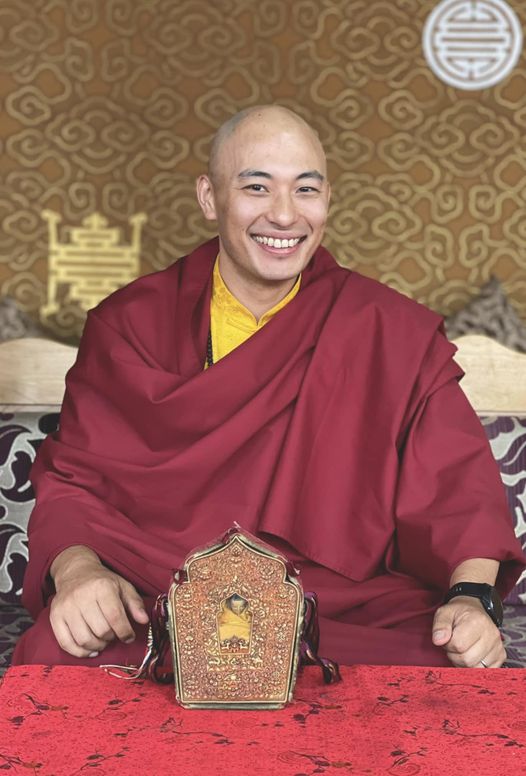
Host: Rinpoche, can you share something about the Kagyu tradition, and especially with regard to Shangpa Kagyu-la for the audience members who are unfamiliar.
Kalu Rinpoche: First of all, all the teachings that we know as a Vajrayana Buddhist is all linked with Buddha Shakyamuni when he transformed himself in the Kalachakra. You know, so that is all linked to that. There’s no such thing as a, you know, something that is made up, few centuries ago.
You know, whether we consider ourselves as a Nyingma, Sakya, Gelug, Kagyu, Jonang, Shangpa and also here, Drukpa Kagyu, you know, all of it has linked with the Buddha Shakyamuni. That’s a one thing. That’s a very important thing. So it’s not like a different agenda that we are going against each other or any sort of thing like that.
And then of course, the བཀའ་བརྒྱུད་ཆེ་བཞི་ཆུང་བརྒྱད “ka gyü che zhi chung gyé” [The four great and eight lesser Kagyu lineages] is a separate lineage that is linked with the Gampopa and the Tilopa and Naropa, and Marpa, Mila, Gampopa, that it. And then from the Gampopa lineage, then there’s a vast different lineage within the Kagyupa sect.
But the Shangpa Kagyu is not really originated from the Gampopa, at all. Shangpa Kagyu has been existed parallelly around the same time.
Because during the Songtsen Gampo time, there was a flourish of Buddhism, Buddhist ideas, as Guru Rinpoche traveled to Tibet. And later on, Guru Rinpoche also, you know, manifest himself as a Dorje Drolö in Paro Taktsang, you know, so we have all these different manifestations of Guru Rinpoche, you know? So in the time of Guru Rinpoche, of course there was a noble king, emperor, but then there was an age of decline of Buddhist teachings.
[…] Yes, Lang Dharma [persecution of Buddhism by the king Lang Darma]. And then during that time, many people still seek for the spiritual path, knows about Buddhism, and the Khyungpo Naljor, he actually was a Bönpo practitioner, until he was 50 years old. But since he was young, he always had this prophecy, the Indian sadhu came to his home, and then gave a nectar blessing, and said “this boy will go to India, will receive all the teachings from 150 masters, he will bring back to Tibet, and he will spread the teachings of the Buddha in the four different directions, fearless as a lion itself” so that was the prophecy. But prophecy tend to be, how do I say, quite a long time, you know?
So until he was 50 years old, he was a Bönpo, and then after that he became a Kadampa practitioner, which is the lineage of the Atisha, he was, so for a while he was a practitioner of that, and then after few months and years, then he went cross the border through Nepal, he went to India and then he received teachings from the Niguma, she is the elder sister of Naropa.
So she, herself, her guru is Saraha, and as well as Vajradhara, in her ultimate level, in terms of connection. And then, the other teachers that he had was Sukhasiddhi, also happened to be another Indian lady. So both of them, they are like a dakini, enlightened being, and a great practitioner, enlightened being. And then she gave all the teachings of the Shangpa Kagyu.
And when you say Shangpa Kagyu, it’s a collective different method of teachings. Like an example, the Shangpa lineage, holds the lineage of the Chakrasamvara practice, the Five Tantric Deities, and as well as the lineage of the Six Armed Mahakala, and the lineage of the Six Yogas of Sukhasiddhi, and the Six Yogas of Niguma, and as well as the Five Jewels of Niguma. So these, all these five combined, is seen as a Shangpa Kagyu.
So then, later on, when he went back to Tibet and then where he settled, was the Shang province, or region. Just like a Gampopa, you know Gampopa is the name of the mountain and the hat and replica, you know, like an example, the Drukpa Kagyu has a replica of the mountain. So many of the masters, you know, their lineage name is based on where they have spent the time most.
But when, since I was very young, I had not so much ideas about the Shangpa lineage. I was just, you know, going into the monastery and studying. But when I was in the retreat, I opened a text of the Shangpa lineage master, Khyungpo Naljor, and when I read that history, I couldn’t hold my tears back, it was like reconnecting to that story, you know, you feel like you know that story.
And then I couldn’t lie to myself, and from the age of 15, I said to myself, “I will dedicate my life fully to the Shangpa Lineage”.
And then when I researched even further, then my predecessor, he actually, he did the three years retreat, you know, Shangpa tradition, when he was 14 years old, same as me. You know, so, so, and then also he established three years retreat, because previous Kalu Rinpoche, he was the first Vajrayana master who traveled to the West and who established a three years retreat tradition for male and female in the 1970s.
So I try to continue that legacy. Because when you say lineage, it’s not so much to do with the blood line, you know? So it’s more to do with the, how much you have dedicated fully into the Dharma, and what you have understood, and how you can help other people. You know, genuinely. So that is the essence of the lineage, and that comes down to the practitioner doing retreat.
H. E Kalu Rinpoche talks to Karma Dendup about Vajrayana Buddhism, Shangpa Kagyu, Niguma Yoga and many more during the Fourth International Conference on Vajrayana Buddhism at The Centre for Bhutan and GNH Studies. (18′ 05”)
To be continued …
Comments are closed.